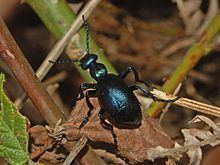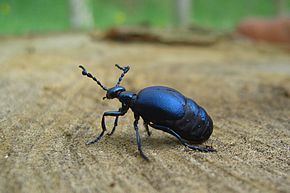Higher classification Meloe | Family Meloidae Scientific name Meloe violaceus Rank Species | |
 | ||
Similar Meloe, Beetle, Meloe proscarabaeus, Insect, Blister beetle | ||
Violet oil beetle meloe violaceus
Meloe violaceus, the violet oil beetle, is a species of oil beetle belonging to the family Meloidae subfamily Meloinae.
Contents
- Violet oil beetle meloe violaceus
- Meloe violaceus col meloidae violetter lk fer violet oil beetle
- References
These beetles are present in most of Europe, in East Palearctic ecozone, in the Near East and in North Africa.
This species is characterized by hypermetamorphosis, a kind of complete insect metamorphosis in which, in addition to the normal stages of larva, nymph and imago, they have several others, with great differences in appearance and way of life.

The body of Meloe violaceus is 10–30 millimetres (0.4–1.2 in) long, females are somewhat larger than the males. These beetle are black-blue or violet-blue, head and pronotum are very finely dotted and the elytra are quite shorter than the abdomen, as in other Meloinae species.

The adults live on a sunny, dry area with flowering plants, feeding on pollen.
In May–June the female digs into the soil 20–30 millimetres (0.8–1.2 in) deep cylindrical holes, where they lay a very large quantity of eggs (about 2,000–10,000).

After about a month larvae emerge from eggs and climb up on grass or on flowers, waiting to cling to the thorax of approaching potential host insects seeking pollen or nectar.

The larvae have an exclusively parasitic life, primarily in the nests of solitary bees, or sometimes of locusts. If the larvae have inadvertently selected a honey bee, they die in the hive and may cause serious damage.
When the host female bee lays eggs in its cells, the first-stage larva of the violet oil beetle eats the eggs of the bee, increases in volume and becomes the second-stage larva, which continues its development eating honey and pollen. The larva, after other two stages, forms the nymph and finally the imago.
